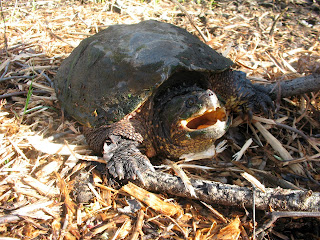On my commute after work Monday, April 17, 2012 I was nearly home, driving on a country road and thinking about what I might be having for dinner when I swerved to miss what I thought was a large piece of mossy wood in the middle of the road. As I passed it, I saw that what I had mistakenly assumed was a broken branch was actually a very live snapping turtle.
Stopping the car I backed up, put on my 4 way lights and got out to attempt to redirect this turtle out of harms way.
I was always of the belief that turtles were slow and deliberate in their movements, but when I stooped to pick this one up, he spun around surprising me with a level of speed and agility that I was not expecting.
 I managed to grab him by the sides of the shell out of reach of his large mouth and carried him back into the woods and swampy area which bordered the road. Putting him down I returned to the car to get my camera so I could take a few photos.
I managed to grab him by the sides of the shell out of reach of his large mouth and carried him back into the woods and swampy area which bordered the road. Putting him down I returned to the car to get my camera so I could take a few photos.
A little research when I got home revealed that roadways are one of the most significant threats to the health and welfare of our area turtles with thousands of them being killed each year province wide. The concern with road mortality is not simply that animals are being killed, but rather that the mortality rate in many places is high enough to completely wipe out populations.

This is especially true of Ontario’s turtles, which have long lifespans (over 70 years in some species) and low rates of reproduction. Consequently, the death of even a few individuals a year on roads will cause populations to decline, as they have sharply in Ontario.
Seven of Ontario’s eight turtle species are already on the Species at Risk in Ontario list.
Dundas is blessed to have a fairly diverse and plentiful turtle population. In the months of May and June and early July turtles can be found crossing roads in search of nesting grounds. Some of these common crossing areas are noted with road signs such as this.
During these months as well as autumn when turtles are heading to their hibernation sites, extra care should be taken when driving in these areas.
Currently six native species and one introduced species of turtles can be found in Cootes Paradise and the Dundas Valley watershed. The most common being the midland painted turtle and the common snapping turtle. Midland painted turtle can be found in various wetland areas, frequently basking on logs and rocks emerging from the surface of the water. I spotted the following young one last spring in a marshy area bordering the rail trail near the Dundas Valley Trail Centre.
Common snapping turtles, while abundant, are less often observed since they bask infrequently. The largest species of turtle found in Ontario and in fact all of Canada, adult snappers can weigh between 4–16 kg and the carapace (shell) can measure 20–36 cm in length.
Other turtles seen although much less frequently are the Common Map turtle, Blanding’s turtle, Common Musk turtle and Eastern Spiny Softshell.
The red-eared slider is not a native turtle but has been found in the wild as a result of being released by irresponsible pet owners.
Heading home, I was pleased that I had been able to save this turtle at least for today.
Make sure you do your part and take extra care when travelling roads that border turtle habitats.
Don't forget, we’re also on Facebook. Please visit and “LIKE” us! https://www.facebook.com/pages/Dundas-Valley-and-beyond/120774278042380
Visit our page for photos as well as current information on trail conditions and events. Help spread the word!!




Great post and pics. Wow good thing you moved quick enough..
ReplyDelete